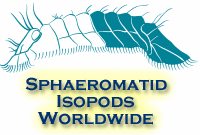| Abstract |
In recent years the pace of exotic species introduction and invasion has accelerated, particularly in estuaries and wetlands. Species invasions may affect coastal ecosystems in many ways. Alteration of sedimentary environments, through structure formation and burrowing, has particularly dramatic effects on coastal habitats. This study examines modification of channel bank and marsh edge habitat by the burrowing Australasian isopod Sphaeroma quoyanum Milne Edwards, in created and natural salt marshes of San Diego Bay and San Francisco Bay. Abundance and distribution patterns of this isopod species, its relationships with habitat characteristics, and its effects on sediment properties and bank erosion were examined seasonally, and in several marsh microhabitats. Mean isopod densities were 1541 and 2936 individuals per 0.25 m(2) in San Francisco Bay, and 361 and 1153 individuals per 0.25 m(2) in San Diego Bay study sites during December and July 1998, respectively. This isopod forms dense, anastomosing burrow networks. S. quoyanum densities did not differ as a function of location within creeks or location in natural versus created marshes. Burrows, which are on average 6 mm wide and 2 cm long, were associated with firm sediments containing high detrital biomass. Although erosion is a natural process along salt marsh banks, enclosure experiments demonstrated that isopod activities can enhance sediment loss from banks. In areas infested with S. quoyanum, losses may exceed 100 cm of marsh edge per year. The effects of habitat alteration by this invading species are likely to increase in severity in the coastal zone as these ecosystems become degraded. |

















